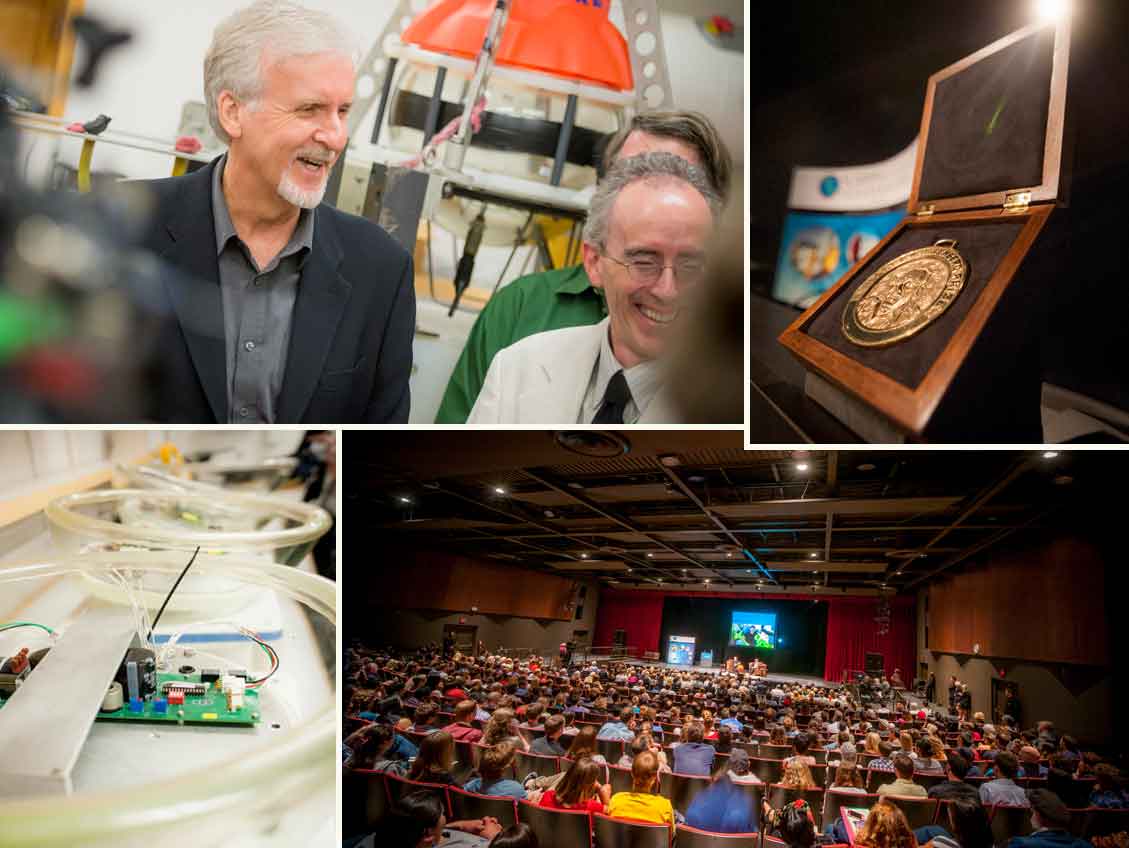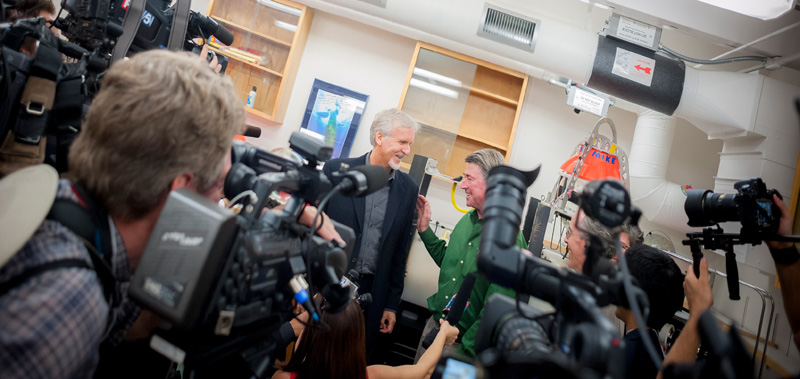
By:
- Robert Monroe
Published Date
By:
- Robert Monroe
Share This:
Filmmaker James Cameron Honored on Campus for Contributions to Understanding Deep Ocean

Photos by Erik Jepsen/UC San Diego Publications
James Cameron and his inner child visited UC San Diego Friday.
The acclaimed director of “Titanic,” “Avatar,” and the “Terminator” films was at Mandeville Auditorium to receive the 2013 Nierenberg Prize for Science in the Public Interest. Mostly Cameron won it for his historic March 2012 dive to the Mariana Trench, the deepest part of the world ocean, a feat he likes to say shows what people can accomplish “with no adult supervision.”
But the prize also represented a career achievement award given to a man who described his blockbuster movies as merely the sources of money that pay for more exploration. Cameron lamented that the deep oceans represent an area the size of North America that remains unexplored, but too many people overlook this vast region as a frontier to discover in favor of space.
“There’s a perception that we’ve explored this planet, and that’s just simply wrong,” he said. “Somehow we managed to stumble into the 21st century thinking we’ve explored the entire world but having missed an entire continent.”
Cameron formally donated a lander used during his expedition, named DEEPSEA CHALLENGE, and the $25,000 that comes with the Nierenberg Prize. Before addressing a sold-out crowd at Mandeville, he visited the new lab at UC San Diego’s Scripps Institution of Oceanography launched by his donation. The Lander Lab will support future uses of the lander, an instrument system that can be sent to the deepest parts of the ocean outfitted with a variety of components that can deliver information on marine life, geochemistry, tectonics and other phenomena of interest to individual researchers.
Cameron noted that the submersible he piloted got all the publicity – the day after his UC San Diego appearance, he was in Los Angeles to kick off its countrywide tour – but the relatively low-cost, easily transportable lander had the potential to open up the oceans to more exploration.
“In terms of getting actual science done, I think this is a really powerful platform,” Cameron said, showing off the lander – his only companion on the seafloor – to reporters.
A self-described “science groupie,” Cameron got a chance to geek out talking about the science and engineering behind DEEPSEA CHALLENGE with Scripps marine microbiologist Doug Bartlett and longtime Scripps development engineer Kevin Hardy at the Lander Lab press briefing. Speaking with a breezy enthusiasm, he credited Bartlett, the chief scientist of DEEPSEA CHALLENGE, and Hardy, the designer of the lander, for their roles adding scientific and engineering value to the expedition. He noted that Bartlett scrambled to take a routine engineering trial of the lander and Cameron’s submersible a few months before his March 26, 2012 dive and made it into a science mission. The test dive in New Britain Trench off Papua New Guinea to a depth of five miles yielded not only information about the performance of the devices but a trove of deep-sea organisms recovered intact by a baited trap mounted on the lander. It was the first time people had explored the trench beyond remote soundings.
The lander and the bright green torpedo-shaped submersible that Cameron piloted to a depth of 35,376 feet in the western Pacific Ocean are both rated to a depth of 11 kilometers (36,089 feet). That means that “there isn’t one place in the entire volume of the ocean that you can’t go to now,” Cameron noted.
The Nierenberg Prize, awarded annually by Scripps, is named for William A. Nierenberg (1919-2000), a renowned national science leader who served Scripps Oceanography as director from 1965 to 1986. Past recipients have included Walter Cronkite, Jane Goodall, and Richard Dawkins.
In introducing Cameron, UC San Diego Chancellor Pradeep K. Khosla quipped that he struggled before the event to figure out ways in which Cameron was like him, finally realizing that they both shared a love of robotics. Nico Nierenberg, the son of William Nierenberg, noted before presenting the Nierenberg Prize medal to Cameron that Cameron’s contributions – from 3-D underwater cameras to the special foam used in the structure of the submersible – have advanced filmmaking and ocean exploration in equal measure.
Cameron’s professional connection with the oceans dates back at least to his 1989 film “The Abyss,” the first film for which he developed specialized camera housings and lighting for underwater photography.; Before he directed the Academy Award-winning film “Titanic,” he made a documentary chronicling Cameron’s own visit to the sunken cruise liner and filming of it through special robotic cameras.
Somewhere along the way, Cameron started thinking about visiting the deepest part of the ocean as a “mental exercise” that evolved into what-ifs and feasibility studies.
“Once you have a picture of it in your mind – it’s kind of a curse – you just have to build it and see if it works,” he told interviewer and Scripps geophysicist John Orcutt during the Mandeville event. “It always starts that way.”
More than 50 years stand between the first visit by humans to the Mariana Trench, located in the western Pacific Ocean near Guam, and Cameron’s. Pilots Don Walsh and Jacques Piccard took the bathyscaphe Trieste to a different part of the trench in 1960, a few years after Scripps’s Bob Fisher had helped determine the depth of the trench. Several times during the prize-related events Friday, Cameron reflected on his fear, or lack of it, during his own dive to a place that only two other people have been before. The depth of the Challenger Deep within the Mariana Trench subjected his submersible to intense pressures that could have crushed it and killed him had there been a structural failure. He attributed his coolness, even under that pressure, to his faith in engineering and the intimate knowledge of the craft he acquired as it was developed over the course of seven years.
“If you think you’re going to be afraid, don’t do it,” he said in response to a reporter’s question. “We worked on this for seven years, and I would have been stupid for 6.99 years if I were afraid on the day,” he said.
The primary accomplishment of the dive, Cameron said, is that at journey’s end, the submersible he piloted will have an interesting story behind it to impress the kids who come and see it, the people he relates to the most.
“Kids especially, they don’t question why you’d want to build a sub and send it to the bottom of the ocean. Of course you’d want to do that. It’s only adults who question that,” he said.
A 3-D documentary film of the dive is being produced by National Geographic. A release date has not been set. The Nierenberg Prize talk will be aired on UCTV at a future date.

Share This:
You May Also Like
Stay in the Know
Keep up with all the latest from UC San Diego. Subscribe to the newsletter today.


